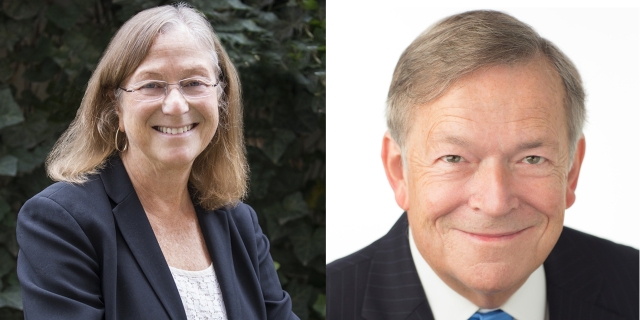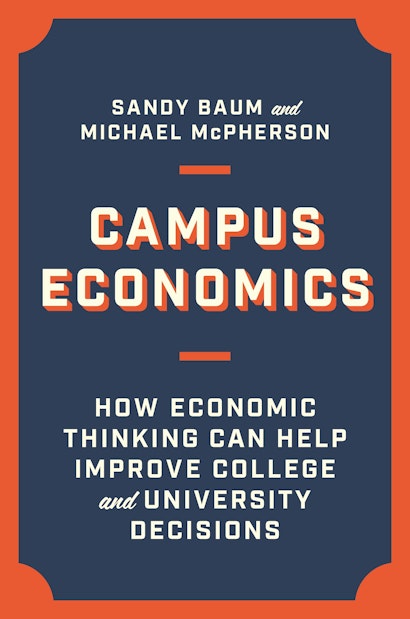Campus Economics provides college and university administrators, trustees, and faculty with an essential understanding of how college finances actually work. Sandy Baum and Michael McPherson explain the concepts needed to analyze the pros, the cons, and the trade-offs of difficult decisions, and offer a common language for discussing the many challenges confronting institutions of higher learning today, from COVID-19 to funding cuts and declining enrollments.
Campus Economics invites a wide range of people on college campuses to think in economic terms. Do you expect non-economists to struggle with (or even be offended by) this idea?
This book is written more for people unfamiliar with economic concepts and reasoning than for those who have studied economics. Our goal is to help people grappling with difficult decisions on campus to think about them in new ways. We aren’t asking people to make the bottom line the top priority or to try put to price tags on all the things that matter to them. But we are asking them to think about the trade-offs involved in most decisions.
Your book includes some vocabulary that might be viewed as professional jargon. You don’t just talk about trade-offs. You explain the idea of “opportunity cost” as the best forgone alternative. You label incremental costs “marginal costs.” Why is this terminology important?
A primary goal of the book is to facilitate conversation among different constituencies on campus. If faculty cringe when trustees talk about “the demand for our services” or administrators engaged in student life are bewildered when the CFO talks about financial aid being a form of “price discrimination,” it is difficult have meaningful exchange of ideas. We believe that a common vocabulary can help move the conversation forward.
You address efforts to cut costs on campus, with a focus on some of the strategies adopted during the pandemic. Is your goal to help people accept these cuts?
Our goal is to help people think critically about budget cuts—not to start either from the position that is it always good to cut the budget to eliminate the fat or from the position that cuts will inevitably be unfair and are unnecessary. Obviously, the answers to specific questions will depend on the circumstances of individual institutions. But we want to encourage people to think about the difference between short-term problems (like the revenue challenges during the pandemic) and long-term problems (like a persistent decline in enrollment). If the administration or the board has proposed a hiring freeze, is the idea to postpone hiring or to permanently cut the number of employees? We want people to think about who will bear the costs—will class sizes rise? Will some people have to work overtime?
Again, we are not pushing towards specific answers. We are encouraging people to ask constructive questions and be open to modifying their views.
(For Sandy Baum) You are a leader in the national debate about college costs, financial aid, and student borrowing. How does that work bear on this volume?
Some of the most challenging trade-offs college leaders face involve raising the tuition revenues needed to sustain their institution’s quality while also providing the financial aid needed to promote access and diversity and live up to colleges’ commitment to values of equity and equality. Pricing, aid, and admissions are complex subjects, but they are not ones that faculty and staff can shy away from. We try in this volume to provide readers with basic tools that will allow them to contribute to on-campus debates about how to manage these difficult trade-offs.
(For Mike McPherson) You used to be a college president. From a president’s point of view, would having faculty and staff read a book like this make a difference?
I have known presidents who were just as happy to have the faculty do their teaching and research, and leave running the place to the professionals. I never felt that way. The faculty—and in some ways the staff even more so—know things about the life of the campus and the learning environment that top administrators really can’t know in the same depth. The better informed and the more open campus dialogue can be about our aims and values, and also about the everyday choices we have to make the better off we will be. My hope is that this book might contribute to that end.
You’ve sometimes said that learning some basic economic ideas can “make you a better citizen of your university or college.” What do you have in mind?
More than most organizations, colleges offer opportunities, both formal and informal, for community members to exchange ideas about how to direct the college’s energy and resources toward meeting shared goals. The more you understand about how the college gets and directs its resources, the more persuasive you can be in making the case for your preferred course of action.
Can you give an example?
Sure. Let’s say you are convinced that majors in your department will benefit from experiencing an intense seminar with no more than ten students in their junior year. You could make that work by just having bigger classes in the rest of the courses in your department, or by limiting the number of students who will be accepted to the major, or by asking the college to get you an extra faculty member or two to carry the extra load. To achieve the result you want, you’re going to need to reflect on how this goal of small junior seminars looks from other points of view, whether it’s your colleagues who may not like their other classes getting bigger—or their number of majors shrinking. Or you’ll have to figure out why the Administration might want to favor your department in allocating faculty.
Economic thinking won’t tell you which path to pursue, or whether any of them will work. But what it will do is remind you that you can’t just get more of the thing you want without wrestling with the question of what kind of impact pursuing your goal has on other people and other goals.
Sandy Baum is a nonresident senior fellow at the Center on Education Data and Policy at the Urban Institute and professor emerita of economics at Skidmore College. Michael McPherson is president emeritus of the Spencer Foundation and Macalester College. They are the authors of Can College Level the Playing Field? Higher Education in an Unequal Society (Princeton).

